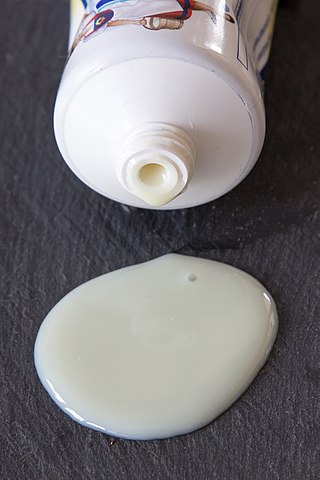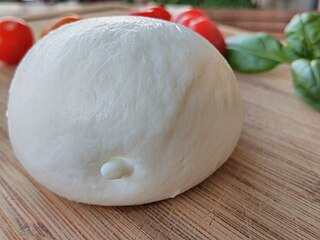
Rennet is a complex set of enzymes produced in the stomachs of ruminant mammals. Chymosin,its key component,is a protease enzyme that curdles the casein in milk. In addition to chymosin,rennet contains other enzymes,such as pepsin and a lipase.

Chymosin or rennin is a protease found in rennet. It is an aspartic endopeptidase belonging to MEROPS A1 family. It is produced by newborn ruminant animals in the lining of the abomasum to curdle the milk they ingest,allowing a longer residence in the bowels and better absorption. It is widely used in the production of cheese.

Casein is a family of related phosphoproteins that are commonly found in mammalian milk,comprising about 80% of the proteins in cow's milk and between 20% and 60% of the proteins in human milk. Sheep and cow milk have a higher casein content than other types of milk with human milk having a particularly low casein content.

Whey is the liquid remaining after milk has been curdled and strained. It is a byproduct of the manufacturing of cheese or casein and has several commercial uses. Sweet whey is a byproduct resulting from the manufacture of rennet types of hard cheese,like cheddar or Swiss cheese. Acid whey is a byproduct brought out during the making of acid types of dairy products,such as strained yogurt.

Curd is obtained by coagulating milk in a sequential process called curdling. It can be a final dairy product or the first stage in cheesemaking. The coagulation can be caused by adding rennet,a culture,or any edible acidic substance such as lemon juice or vinegar,and then allowing it to coagulate. The increased acidity causes the milk proteins (casein) to tangle into solid masses,or curds. Milk that has been left to sour will also naturally produce curds,and sour milk cheeses are produced this way.

Condensed milk is cow's milk from which water has been removed. It is most often found with sugar added,in the form of sweetened condensed milk,to the extent that the terms "condensed milk" and "sweetened condensed milk" are often used interchangeably today. Sweetened condensed milk is a very thick,sweet product,which when canned can last for years without refrigeration if not opened. The product is used in numerous dessert dishes in many countries.

Blue cheese is any of a wide range of cheeses made with the addition of cultures of edible molds,which create blue-green spots or veins through the cheese. Blue cheeses vary in taste from very mild to strong,and from slightly sweet to salty or sharp;in colour from pale to dark;and in consistency from liquid to hard. They may have a distinctive smell,either from the mold or from various specially cultivated bacteria such as Brevibacterium linens.
Syneresis,in chemistry,is the extraction or expulsion of a liquid from a gel,such as when serum drains from a contracting clot of blood. Another example of syneresis is the collection of whey on the surface of yogurt. Syneresis can also be observed when the amount of diluent in a swollen polymer exceeds the solubility limit as the temperature changes. A household example of this is the counterintuitive expulsion of water from dry gelatin when the temperature increases. Syneresis has also been proposed as the mechanism of formation for the amorphous silica composing the frustule of diatoms.

Tong sui,also known as tim tong,is a collective term for any sweet soup served as a dessert typically at the end of a meal in Chinese cuisine. Tong sui originated in the Lingnan region of China,including Guangdong,Guangxi,Hainan,Hong Kong,Macau,and some parts of other provinces in China. Therefore,in the narrow sense,the term tong sui is used to refer to soupy desserts from Lingnan,while occasionally it is also used in the broad sense,referring to any soupy dessert in Chinese-speaking regions.

Easy Cheese is the trademark for a processed cheese spread product distributed by Mondelēz International. It is also commonly referred to by generic terms such as "spray cheese","squirt cheese","cheese in a can",and/or "cheese cans". Easy Cheese is packaged in a metal can filled with air covered with a plastic cap that reveals a straight,flexible nozzle where the cheese is extruded.

Ostkaka,ost meaning "cheese" and kaka meaning "cake" in Swedish,is known as Swedish cheesecake or Swedish curd cake,it is a Swedish dessert that has its roots in two different parts of Sweden,Hälsingland and Småland,though there are some differences between ostkaka from Hälsingland resembling halloumi in texture,and the soft-grained ostkaka from Småland. Originally,the food comes from Småland,ostkaka is made with raw milk and cheese rennet. However,these days most people simply use cottage cheese instead,which is much faster,and gives the same flavor and texture.

Requeijão is a milk-derived product,produced in Portugal and Brazil. It is a loose,ricotta-like cheese used to make cheese spreads. It can be a good substitute to mild,unsalty ricotta. This variety is sometimes sold in the markets wrapped in fresh corn husks. In El Salvador,cheeses such as requesón can sometimes be transported wrapped in banana leaves instead.

Pasta filata is a technique in the manufacture of a family of Italian cheeses also known in English as stretched-curd,pulled-curd and plastic-curd cheeses. Stretched curd cheeses manufactured using the pasta filata technique undergo a plasticising and kneading treatment of the fresh curd in hot water,which gives the cheese its fibrous structure.
Κ-casein,or kappa casein,is a mammalian milk protein involved in several important physiological processes. Chymosin splits K-casein into an insoluble peptide and water-soluble glycomacropeptide (GMP). GMP is responsible for an increased efficiency of digestion,prevention of neonate hypersensitivity to ingested proteins,and inhibition of gastric pathogens. The human gene for κ-casein is CSN3.

Tofu is a food prepared by coagulating soy milk and then pressing the resulting curds into solid white blocks of varying softness:silken,soft,firm,extra firm. Tofu is also known as bean curd in English. Tofu originated in China and has been consumed in the country for over 2,000 years. Tofu is a traditional component of many East Asian and Southeast Asian cuisines. In modern Western cooking,it is often used as a meat substitute.

Zingibain,zingipain,or ginger protease is a cysteine protease enzyme found in ginger rhizomes. It catalyses the preferential cleavage of peptides with a proline residue at the P2 position. It has two distinct forms,ginger protease I (GP-I) and ginger protease II(GP-II).

Sour cream is a dairy product obtained by fermenting regular cream with certain kinds of lactic acid bacteria. The bacterial culture,which is introduced either deliberately or naturally,sours and thickens the cream. Its name comes from the production of lactic acid by bacterial fermentation,which is called souring. Crème fraîche is one type of sour cream with a high fat content and less sour taste.

Shawan Ancient Town is an 800-year-old town located in the Panyu District of Guangzhou in southern China,founded during the Song dynasty. It is traditionally linked to the historical and folk Lingan culture.
















